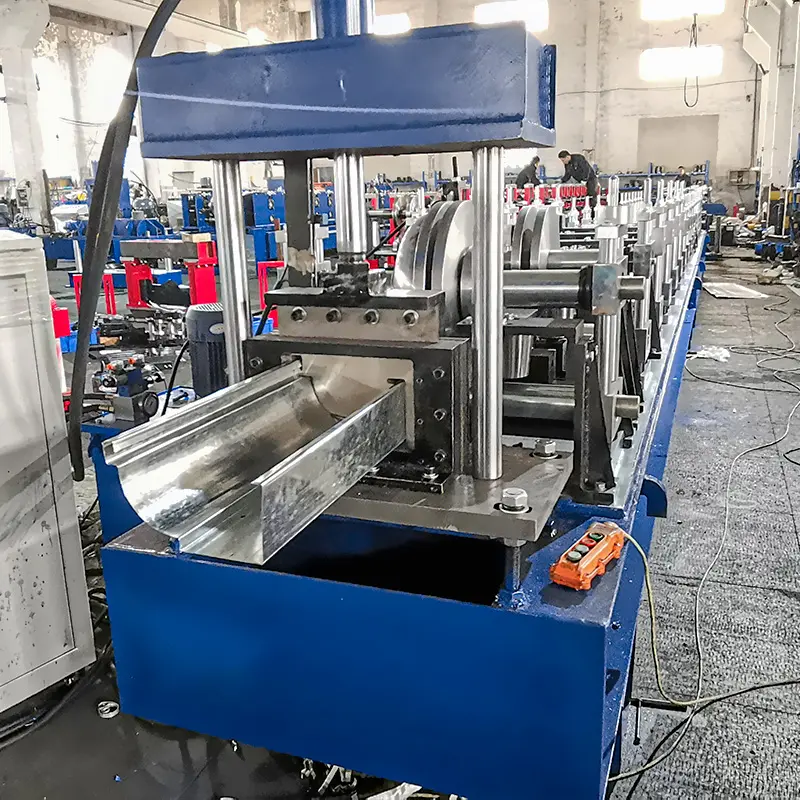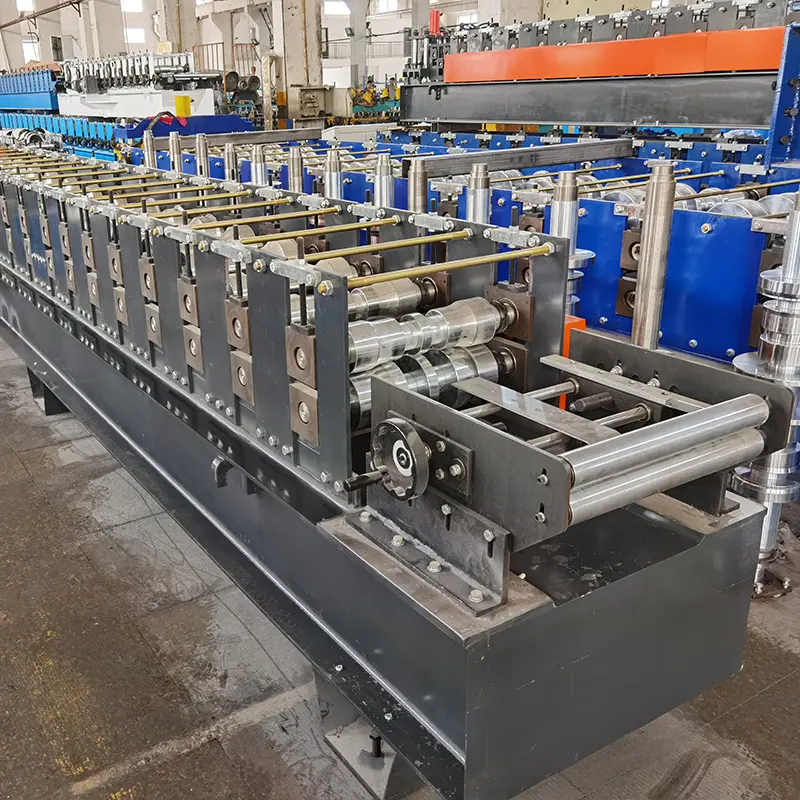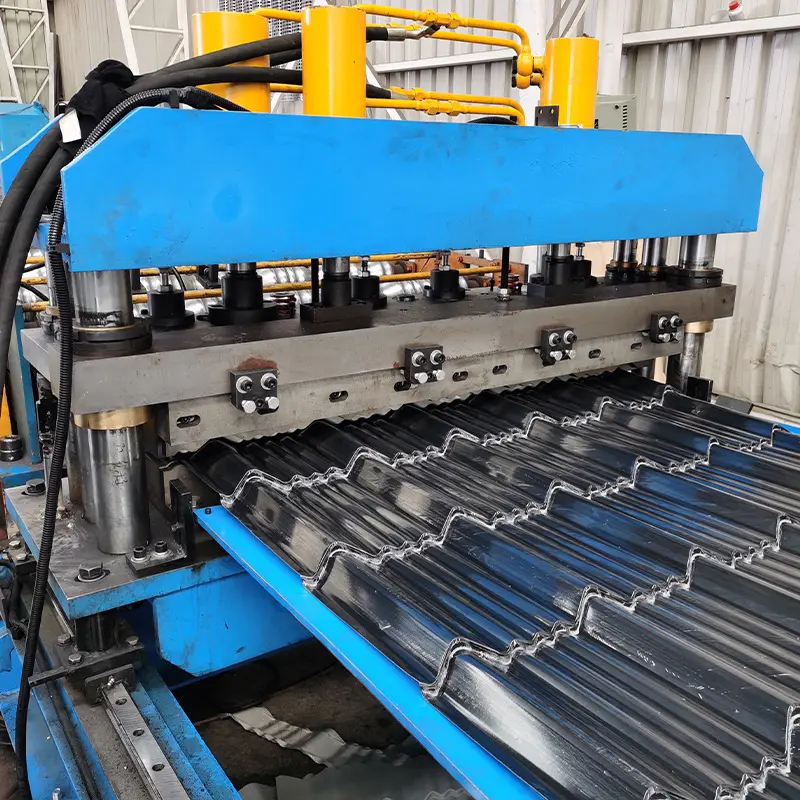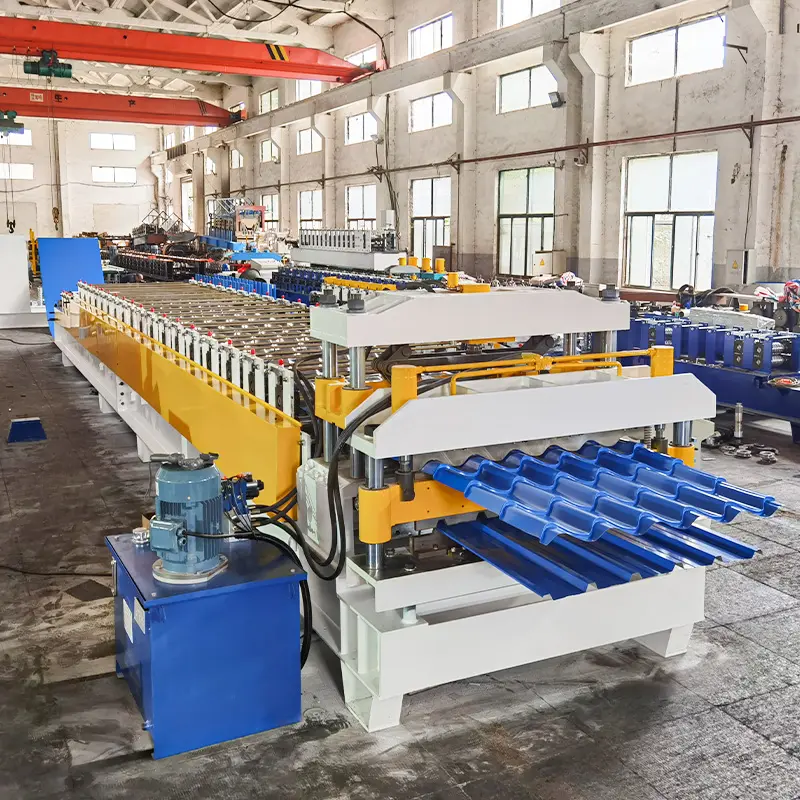ভূমিকা
In the realm of manufacturing, efficient and precise metal forming plays a crucial role. One such machine that revolutionized the process is the U channel roll forming machine. This article explores the various aspects of U channel roll forming machines, including their types, working principles, key features, applications, and maintenance.
What is a U Channel Roll Forming Machine?
A U channel roll forming machine is a specialized piece of equipment used in metalworking to shape flat metal strips or coils into U-shaped channels with consistent cross-sections. It utilizes a continuous bending process, where the metal strip passes through a series of roller dies, gradually forming it into the desired U shape.
Benefits of Using a U Channel Roll Forming Machine
Using a U channel roll forming machine offers several benefits:
- High Precision: U channel roll forming machines can achieve high levels of precision and accuracy in producing U-shaped channels with consistent dimensions.
- Increased Efficiency: These machines can operate at high speeds, enabling faster production rates and reducing manufacturing lead times.
- Cost-effective: U channel roll forming machines minimize material waste and scrap, resulting in cost savings for manufacturers.
- Versatility: They can handle various metals, including steel, aluminum, and stainless steel, allowing manufacturers to produce U channels for different applications.
- Flexibility: U channel roll forming machines offer customization options, allowing manufacturers to produce U channels with different dimensions and profiles.

Types of U Channel Roll Forming Machines
There are different types of U channel roll forming machines available in the market, catering to diverse production requirements:
1. Single Station U Channel Roll Forming Machine
The single station U channel roll forming machine is a manual or semi-automatic machine suitable for small-scale production. It requires manual adjustments for different channel sizes and shapes.
2. Double Station U Channel Roll Forming Machine
The double station U channel roll forming machine allows simultaneous forming of two U channels, increasing production efficiency. It offers faster changeover times between different channel profiles.
3. Automatic U Channel Roll Forming Machine
The automatic U channel roll forming machine is a fully automated solution equipped with advanced controls and computerized systems. It offers high-speed production, precise forming, and quick changeover between different channel profiles.
Working Principle of a U Channel Roll Forming Machine
The working principle of a U channel roll forming machine involves several sequential steps:
- Material Feeding: The metal strip or coil is fed into the machine through the entry section.
- Leveling and Pre-Punching: The strip passes through leveling rollers, ensuring uniform flatness. Pre-punching stations may create holes or slots as required.
- রোল গঠন: The strip enters the roll forming section, where a series of rollers progressively shape it into a U-shaped channel. Each roller imparts a specific bend or profile to the metal.
- Cutting and Shearing: Once the desired length is achieved, the machine cuts the U channel to the required size using cutting blades or shearing mechanisms.
- Exit Section: The finished U channels are conveyed out of the machine through the exit section for further processing or packaging.

Key Features and Components of a U Channel Roll Forming Machine
A typical U channel roll forming machine consists of the following key features and components:
Entry Section
The entry section is where the metal strip or coil is loaded into the machine for processing. It may include a decoiler or a coil holder to provide a continuous feed.
Leveling and Pre-Punching Section
The leveling and pre-punching section ensures that the metal strip is flat and uniform in thickness. Pre-punching stations may be present to create holes, slots, or other custom features.
Roll Forming Section
The roll forming section comprises a series of rollers arranged in a specific sequence. Each roller gradually bends the metal strip into the desired U-shaped profile. The number and arrangement of rollers vary depending on the complexity of the channel profile.
Cutting and Shearing Section
The cutting and shearing section is responsible for cutting the formed U channel to the required length. It may employ cutting blades or shearing mechanisms to achieve clean and accurate cuts.
Exit Section
The exit section serves as the outlet for the finished U channels. It may include a conveyor or stacking system to collect and transport the channels for further processing or packaging.
Factors to Consider when Choosing a U Channel Roll Forming Machine
When selecting a U channel roll forming machine, several factors should be taken into account:
- Production Speed and Capacity: Consider the required production volume and the machine’s speed capabilities to ensure it meets your production demands.
- Material Compatibility: Check whether the machine can handle the specific type and thickness of metal you intend to use for U channel production.
- Customization Options: Evaluate the machine’s flexibility in terms of producing U channels with different dimensions, profiles, and custom features.
- Machine Durability and Reliability: Ensure the machine is built with high-quality components and has a reputation for durability and reliability to minimize downtime and maintenance costs.

Applications of U Channel Roll Forming Machines
U channel roll forming machines find applications in various industries:
Construction Industry
U channels are commonly used in construction for framing structures, support beams, and installation of suspended ceilings.
Automotive Industry
U channels are utilized in the automotive sector for manufacturing vehicle frames, structural components, and chassis reinforcements.
Shelving and Storage Systems
U channels are an essential component in the fabrication of shelving systems, racks, and storage units used in warehouses, retail stores, and other storage facilities.
Electrical Enclosures
U channels are employed in the production of electrical enclosures and cabinets, providing support and structural integrity to the equipment.
Furniture Manufacturing
U channels are incorporated in the manufacturing of furniture frames, partitions, and other structural elements. They provide stability and support to the furniture pieces.
Maintenance and Care for U Channel Roll Forming Machines
Proper maintenance and care are crucial to ensure the optimal performance and longevity of a U channel roll forming machine. Here are some essential practices:
- Regular Cleaning and Lubrication: Keep the machine clean by removing debris, dust, and excess oil. Lubricate the moving parts as per the manufacturer’s recommendations to prevent friction and ensure smooth operation.
- Inspection and Maintenance Schedule: Establish a routine inspection and maintenance schedule to identify any potential issues or wear and tear. Regularly check the rollers, cutting blades, electrical connections, and other components for signs of damage or deterioration.
- Safety Measures: Adhere to safety guidelines and provide adequate training to machine operators. Ensure that safety guards and protective measures are in place to prevent accidents and injuries.
- Professional Servicing: Schedule professional servicing and maintenance by qualified technicians to address any complex issues or repairs. Regular servicing helps identify and resolve problems before they escalate.

উপসংহার
U channel roll forming machines play a vital role in metalworking industries, providing efficient and precise production of U-shaped channels. Their versatility, customization options, and cost-effectiveness make them valuable assets for various applications in construction, automotive, storage systems, electrical enclosures, and furniture manufacturing. By understanding the working principles, key features, and maintenance practices, manufacturers can make informed decisions when choosing and operating a U channel roll forming machine.
FAQs
1. Can a U channel roll forming machine handle different metal thicknesses?
Yes, U channel roll forming machines are designed to handle various metal thicknesses, allowing flexibility in production.
2. How fast can a U channel roll forming machine produce U-shaped channels?
The production speed of a U channel roll forming machine depends on factors such as machine capabilities, material type, and complexity of the channel profile. It can range from a few meters per minute to higher speeds for automatic machines.
3. Are U channel roll forming machines customizable for different channel dimensions?
Yes, U channel roll forming machines offer customization options, allowing manufacturers to produce U channels with different dimensions, profiles, and custom features.
4. What maintenance practices are necessary for a U channel roll forming machine?
Regular cleaning, lubrication, inspection, and professional servicing are essential maintenance practices for U channel roll forming machines. Following safety measures and adhering to maintenance schedules ensure optimal performance and longevity.
5. What industries benefit from using U channel roll forming machines?
U channel roll forming machines find applications in various industries, including construction, automotive, storage systems, electrical enclosures, and furniture manufacturing. They provide the necessary structural support and stability for a wide range of products and components.
Frequently Asked Questions (FAQ)
1) What tolerance can a modern U Channel Roll Forming Machine hold over long lengths?
- With servo-driven flying cut-off and in-line laser measurement, best-in-class lines hold ±0.5–0.8 mm over 6–10 m on mild and galvanized steel; typical legacy lines are ±1.0–1.5 mm.
2) How do I minimize bow, twist, and end flare on U channels?
- Use proper pass design, anti-bow fixtures, pre- and post-straightening, controlled strip tension, and roll tooling radii matched to material thickness. Validate with in-line laser profile gauges.
3) Can one machine produce multiple U-channel sizes quickly?
- Yes. Quick-change cassettes and recipe-based roll gap presets cut mechanical changeover to 10–30 minutes. Servo-electric punching heads allow fast switchovers for hole/slot patterns.
4) Which materials and thicknesses are most common for U channels?
- 0.6–3.0 mm thickness in galvanized steel (ASTM A653, EN 10346), cold-rolled steel (ASTM A1008/A1011), aluminum 3003/5052, and stainless 304/316 for corrosion-critical applications.
5) What maintenance tasks have the highest ROI?
- Monthly roll alignment and encoder verification, quarterly bearing inspections, and coolant/lubricant cleanliness. Plants report double-digit scrap reductions after instituting a length calibration routine per coil lot.
2025 Industry Trends for U Channel Roll Forming Machines
- Electrification of actuators: Servo-electric punching and cut-off replacing hydraulics, improving repeatability and reducing oil-related downtime.
- AI-assisted setup: Vision-guided strip centering and ML-recommended roll gaps by coil lot to cut first-off scrap.
- Connected quality: Native OPC UA/MTConnect streams feed MES/ERP for traceability, torque signatures, and automated COA/EPD documentation.
- Sustainability metrics: Purchasers request EPDs; higher recycled-content steel (70–85%) and closed-loop coolants reduce embodied carbon and operating costs.
- Safety upgrades: PLd/PLe safety circuits, light curtains, and digital LOTO checklists are becoming procurement requirements.
2025 Benchmarks and Data Snapshot
| KPI (U-channel production) | 2023 Typical | 2025 Best-in-Class | Operational Impact | Sources |
|---|---|---|---|---|
| Line speed (m/min) | 20–40 | 45–70 | +30–100% throughput | The Fabricator; OEM datasheets |
| Length tolerance over 8 m (± mm) | 1.0–1.5 | 0.5–0.8 | Less rework/fit-up time | OEM manuals; plant case reports |
| First-article scrap (%) | 3–5 | 1–2 | Coil savings, faster changeover | Industry case studies |
| Changeover (size/pattern) min | 45–90 | 10–25 | Higher SKU agility | Bradbury/ASC resources |
| Energy per 1000 m (kWh) | 35–50 | 25–34 | Lower operating cost | DOE AMO guidance |
| Recycled content in steel (%) | 50–65 | 70–85 | Lower EPD values | World Steel Association |
Authoritative references:
- World Steel Association: https://worldsteel.org
- U.S. DOE Advanced Manufacturing: https://www.energy.gov/eere/amo
- MTConnect Institute: https://www.mtconnect.org
- The Fabricator (roll forming): https://www.thefabricator.com
- ASTM Standards (A1008/A1011/A653): https://www.astm.org
- EN 10346 overview: https://standards.cen.eu
Latest Research Cases
Case Study 1: AI-Assisted Setup for Multi-SKU U Channels (2025)
- Background: A construction profiles plant produced 14 U-channel SKUs with frequent coil changes; high first-off scrap and slow changeovers.
- Solution: Implemented camera-based strip centering, ML-driven roll gap presets per coil cert, and servo-electric flying shear. Integrated OPC UA to MES for recipe governance and length auto-verification.
- Results: First-article scrap cut from 4.5% to 1.7%; average changeover reduced from 62 to 21 minutes; OEE improved from 61% to 77%; downstream welding rework down 19%.
Case Study 2: Electrified Punching Retrofit for Electrical Enclosures (2024)
- Background: OEM making stainless U channels (1.2–1.5 mm, 304) faced hydraulic punch drift and oil contamination risks.
- Solution: Replaced hydraulic punch with servo-electric unit using absolute encoders; added in-line laser length gauge and temperature-compensated control.
- Results: Hole-to-end accuracy improved to ±0.6 mm over 6–8 m; eliminated hydraulic leaks; energy per 1000 m reduced by 16%; unplanned punch maintenance dropped 80%.
Expert Opinions
- Dr. Taylan Altan, Professor Emeritus, Center for Precision Forming (Ohio State University)
- Viewpoint: “Accurate pass design and controlled bend progression are decisive for U channel straightness and twist. Servo motion allows higher speeds without sacrificing dimensional control.”
- Source: https://cpf.osu.edu
- Ben Taylor, Product Manager, The Bradbury Group
- Viewpoint: “Recipe-driven changeovers with in-line laser metrology are becoming baseline on U Channel Roll Forming Machines targeting ±0.5–0.8 mm over long lengths.”
- Source: https://bradburygroup.com
- Paul Hogendoorn, Manufacturing Data/Connectivity Advisor
- Viewpoint: “Streaming MTConnect data from roll formers delivers rapid payback by exposing scrap, minor stops, and setup losses that spreadsheets miss.”
- Source: https://www.mtconnect.org
Practical Tools/Resources
- Pass design and simulation: COPRA RF (data M) https://www.datam.de/en/copra; UBECO PROFIL https://www.ubeco.com
- Standards for materials and coatings: ASTM A1008/A1011/A653 https://www.astm.org; EN 10346 https://standards.cen.eu
- Structural and application guidance: AISI S100/CFSEI https://www.cfsei.org
- Connectivity/interoperability: MTConnect https://www.mtconnect.org; OPC Foundation https://opcfoundation.org
- Lubrication/tribology best practices: STLE https://www.stle.org
- Industry insights and case articles: The Fabricator https://www.thefabricator.com
Last updated: 2025-10-27
Changelog: Added 5 targeted FAQs; introduced 2025 trends with KPI table and references; included two recent case studies tailored to U-channel production; compiled expert viewpoints; listed practical tools and standards resources
Next review date & triggers: 2026-04-30 or earlier if first-article scrap > 2.5%, changeover time > 30 minutes, length tolerance worse than ±1.0 mm over 8 m, or OEE < 70%
